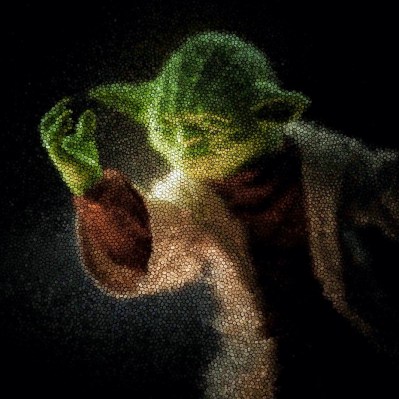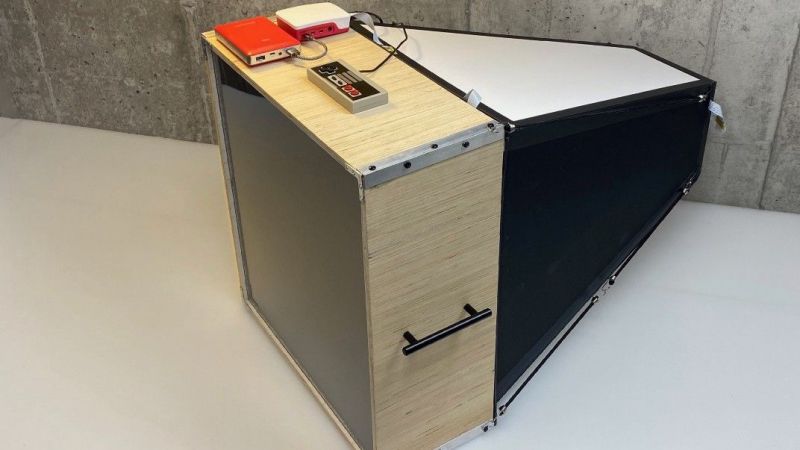What happens when you mix over 23,000 coffee stirrers and a Raspberry Pi camera together? Probably nothing except for a mess, unless you very specifically pack the plastic straws and orient the camera just right. In that case, you get this very cool lenless digital straw camera that takes artfully ghostly images.

Actually, lensless is a bit of a reach for [Adrian Hanft]’s creation. While the camera he’s using to grab the image has a lens, the objective, for lack of a better term, is just a tightly packed bundle of straws. We’ve seen this approach to photography before, but there the camera used film placed at the back of the straw bundles to capture the pixelated image.
Here, a ground glass screen stands in for the film; a long lightproof box behind that provide a place to mount a camera to capture the images. Cleverly, [Adrian] built the camera mount from Lego, allowing cameras and lenses to be quickly swapped out. A Nintendo gamepad controller talks to custom software running on a Raspberry Pi and allows the photographer to control exposure and scroll through pictures using a smartphone as a display. There’s a short build video below, for those who can’t get enough of straw-packing techniques.
As with the film version of this camera, we just love the look of the photographs that come from this — the texture of the straw honeycomb and the defocused subject make for a striking effect.
Thanks to [Itay Ramot] for the tip.















So its a reverse shadowmask?
Dammit I wasted half a minute of my life watching a video that didn’t conclude with anything – just a guy filling a box with straws.
Downvote.
To be fair, I did mention that it was about straw-packing.
We need to take a… wait for it… wait for it….. Straw Po!!….
Indeed, and telling so does not make the video any more interesting, A guy stacking straws is just not interesting.
For a teardown of a real camera that uses this technique, here is an old video from MikesElectricStuff of a Spectral Instruments 800 Series 16Mpixel Cooled CCD camera
https://www.youtube.com/watch?v=2WnGhbub6LM
That spectral Instruments 800 series thing is lens-less. However, this contraption is not. From what I gather it just uses some standard camera module to make a picture of the whole thing. How is the result of this any different from using some post processing filter in a program like Gimp (or similar)?
I am a bit mystified about that spectra Instruments camera. Best I understand is that the “wave guide” transfers the picture 1:1 to the CCD sensor (although the glass fibers probably wont be mapped 1:1 to the pixels) But if that is so, then why use such a wave guide at all? Why not simply use a point-light-source?
In the original installation for the Spectral Instruments sensor (a DNA sequencer) the light is generated by chemical reactions between the DNA and some reagents. The waveguides map reaction chambers to pixels in a robust way.
Yeah, it was almost unbearable… And that moment at 0:33? That was the last straw.
+1
Careful—you might get banned for attempting upvotes here in defiance of apparent HaD policy.
BTW, this:
Save my name, email, and website in this browser for the next time I comment.
…does precisely nothing, at least for me. And I don’t think I’ve messed with the HaD cookies in my browser.
I’ve been wanting to try something like this to create a camera that takes parallel projection (instead of perspective) images.
Telecentric lenses for exactly this purpose are relatively common. The industrial machine-vision variety are kind of spendy, but it’s trivial to make your own with just a single magnifying glass: just place it one focal length away from your camera lens’s input pupil. The field of view is (obviously) limited to the diameter of that magnifier, so choose wisely.
Yoda? Really? You couldn’t think of anything else to do with this camera?
Nintendo controller, Lego camera mount, yoga picture… What, you mean like Iron Man?
Someone definitely feels a kinship with the characters from The Big Bang Theory.
There’s a lovely picture of some wildflowers in the article.
Hmmmmm…. Picture flatters me not… I think.
“Image of Yoda photographed through many straws” wait. Yoda is an image! An image that is a projection of a, what, 9 dimensional image abstraction? 9 at the minimum?
Yeah, a straw man, for instance.
deja vu day…. https://hackaday.com/2017/02/18/can-a-bundle-of-soda-straws-be-a-camera/
Although I think I read the article on raspberrypi.org first. The Yoda picture really made an impression on me.
The Yoda looks really cool. I wonder what it would look like as a video camera? That would be neato.
That article was linked in this one.
It’s 1957 calling. They’d like to say a word about a SPECT camera.
It’s not -really- lensless. From the link it looks like the straws are up against a ground glass (so far so good) but the raspberry pi camera and the film camera do seem to have lenses, albeit focused on the ground glass.
Which is exactly why I said, “lensless is a bit of a reach” before pointing out that the camera used to capture the image from the ground glass has a lens.
Use tungsten straws or a CVD coating on plastic ones, plus a scintillator screen then you have an X-ray camera.
So, exactly like a SPECT camera. A few PMTs and some Tc-99m and you have your very own cardiac and bone mets scanner.
Yeah, or an X-ray telescope for your micro-satellite project.
It’s a regular camera. With that straw-thing in front of it. That makes the straws a filter not the lens.
Anyway, nice effect.
To be honest, that’s a bit of a disappointing one. The original straw camera is really a super brilliant idea, as it is so simple and works so beautifully. This thing uses the original concept, makes it basically more complicated and on the way it looses all its charm. :(
Thanks for killing the Earth!
Title is misleading though, there’s a lens on the camera.. What this is, while still cool, is an addon in front of that lens.
so this is the light based negative of https://www.youtube.com/watch?v=WmW6SD-EHVY
How about using a scanner to pick off the image instead of a camera? Just bundle the straws together on bed of the scanner and disable the scanner’s internal light source.